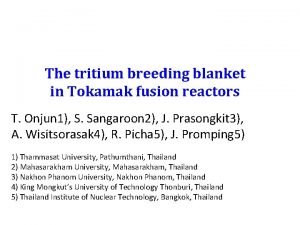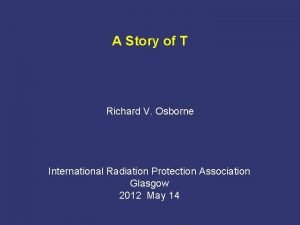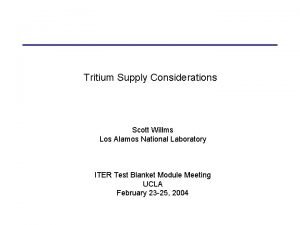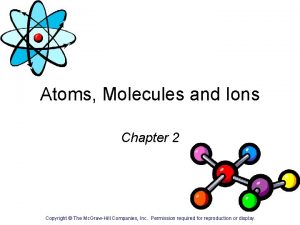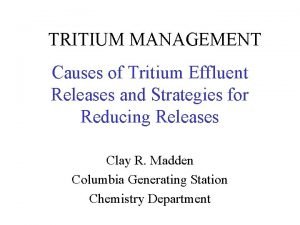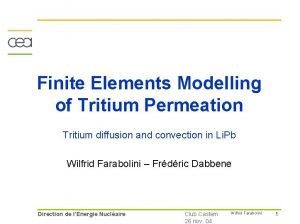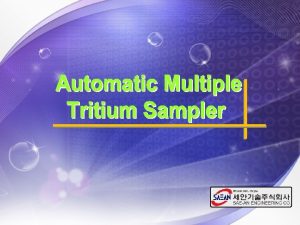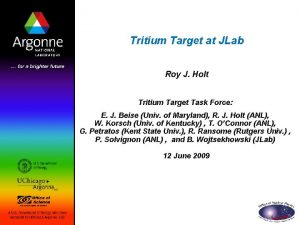MANAGEMENT OF TRITIUM EXPOSURES FOR PROFESSIONALLY EXPOSED WORKERS



















- Slides: 19

MANAGEMENT OF TRITIUM EXPOSURES FOR PROFESSIONALLY EXPOSED WORKERS AT CERNAVODA 1 NPP Catalina Chitu, Vasile Simionov, “CNE-PROD Cernavoda” NPP, Romania 4 th ISOE EUROPEAN WORKSHOP ON OCCUPATIONAL EXPOSURE MANAGEMENT AT NPPs LYON, FRANCE, 24 -26 MARCH 2004

INTRODUCTION • Cernavoda Nuclear Power Plant is a CANDU 6 type NPP, which employs natural uranium as fuel and heavy water as neutron moderator and thermal agent. • The thermal neutron flux in the CANDU reactor, by activation of deuterium, is the major producer of tritium but other nuclear reactions could also produce tritium.

INTRODUCTION • Activation reactions – – – • Ternary Fission • Reconversion of 3 He from 3 H Decay

INTRODUCTION • DTO may escape from moderator and heattransport systems contaminating with DTO vapors the air in the reactor building and thus increasing internal doses. • The ventilation systems were designed to control water vapor concentration; special dryers remove moisture from the air. • The major contributor to the internal dose of professionally exposed workers is the tritiated heavy water (DTO) which is present at many work locations.

TRITIUM CHARACTERISTICS • Exposure to an atmosphere contaminated by tritiated water results in its intake by inhalation and by absorbtion through skin, in a ratio assumed to be 2 to 1. • Vapours of DTO are considered to be of SR 2 absorbtion class: the tritiated water is instantaneously absorbed into body fluids and uniformly distributed among all the soft tissues and is eliminated with a nominal half time of 10 days.

TRITIUM CHARACTERISTICS • In addition a very small fraction is incorporated in non - exchangeable form and eliminated with a much longer half time. • Tritium (H-3) is a pure beta emitter, with an average energy of beta radiation of 0. 0057 Me. V. • Its presence in the body can be detected by measuring the urine samples using the liquid scintillation counting and it presents no detection problems.

INTERNAL DOSIMETRY FOR DTO • The main objectives of individual monitoring for intakes of radionuclides are: - to obtain an assessment of the committed effective dose; - to contribute to the control of operation and the design of the plant; - in the case of accidental exposure, to provide valuable information for the initiation and support of any appropriate health surveillance and treatment.

INTERNAL DOSIMETRY FOR DTO • Professionally exposed workers are subject to a combination of acute and chronic tritium exposure and DTO dosimetry program is based on multiple sample results. • Body DTO concentration is integrated over time and multiplied by the dose rate per unit concentration factor as in the relation:

INTERNAL DOSIMETRY FOR DTO • E - the effective dose in m. Sv, • Ci - the urine concentrations in MBq/L, • ti - the time in days. • Tritium doses are registered into personal records with a recording level of 0. 17 m. Sv.

INTERNAL DOSIMETRY FOR DTO • The committed dose (m. Sv) associated with a 3 H concentration C (MBq/L) is computed as follows: • The dose factor 0. 84 was computed by using tritium physical characteristics, anatomic and metabolic data for Reference Man.

Bioassay for intakes of DTO • Bioassay monitoring for internal dosimetry of DTO involves the sampling of a single void urine sample. • The method consists of mixing 1 m. L of urine sample with 10 m. L of scintillation cocktail. • This mixture is shacked to ensure the homogeneity and then measured by the liquid scintillation spectrometer.

Bioassay for intakes of DTO • A monthly frequency of bioassay submission is used for professionally exposed workers who are infrequently exposed or exposed to low tritium levels. • If the urine tritium concentration is greater than 100 k. Bq/L weekly sampling will be required. • When concentration exceeds 1 MBq/L, the investigation level, daily sample submission is required.

Bioassay for intakes of DTO • Special monitoring is required when planned exposures to DTO are foreseen, the worker should submit additional samples before and after the task completion. • When working conditions are unexpectedly changing and could produce abnormal exposures, all the personnel involved submit additional samples.

Bioassay for intakes of DTO • A chronic unprotected exposure to small tritium dose rate (< 50μSv/h) may lead to internal doses that exceed the intervention level:

Bioassay for intakes of DTO • In case of acute exposure dose-mitigating actions are recommended by the Occupational Medicine Specialist in consultation with Dosimetry Program responsible. • The primary treatment for reducing internal dose from a tritiated water uptake is to accelerate the turnover of body water. This can be done by substantially increasing the fluid intake rate of an individual through oral or intravenous means, and/or using diuretics.

Bioassay for intakes of DTO • Cernavoda NPP experience intakes indicating that a sustained drinking regime gave a clearance half-time of about 5 – 6 days compared with a 10 day normal clearance half-time. • Figure 2 illustrates tritium dynamics in urine following unusual DTO incorporation based on daily measurements. Tritium clearance was accelerated with diuretics under physicians surveillance, which resulted in low tritium effective half-times, 5. 4 days.

Bioassay for intakes of DTO • During the investigation period this worker was not allowed to enter in tritium contaminated areas until the tritium concentration in urine had decrease below 1 MBq/L.

CONCLUSIONS • Tritium is an important contributor to the internal exposure of radiation workers in Cernavoda NPP. Collective dose for professionally exposed workers reached a value of 818. 28 man m. Sv in 2003 and internal doses contribution raised from 1. 9% in 1996 to about 40% in 2002. • Most of the results were below the Recording Level, the majority of recordable doses were less then 1 m. Sv.

CONCLUSIONS • The actual levels of internal doses due to tritium exposures reveal the effectiveness of implementation of the Radiation Safety Policies and Principles, based on the ALARA principles.
 How to speak professionally
How to speak professionally How to groom yourself professionally
How to groom yourself professionally Professionally presented
Professionally presented Tritium magallum
Tritium magallum Tritium breeding blanket
Tritium breeding blanket Tritium half life
Tritium half life Tritium
Tritium Protium deuterium tritium
Protium deuterium tritium There were ____ reported sharps exposures at uf in 2020.
There were ____ reported sharps exposures at uf in 2020. Did investigator assign exposures
Did investigator assign exposures How many splash exposures were reported at uf in 2020?
How many splash exposures were reported at uf in 2020? How many splash exposures were reported at uf in 2020
How many splash exposures were reported at uf in 2020 Types of foreign exchange exposure
Types of foreign exchange exposure Joint management council
Joint management council Workers participation in management
Workers participation in management Example of types of media
Example of types of media Exposed terminal problem
Exposed terminal problem Which rock weathers most rapidly when exposed to acid rain?
Which rock weathers most rapidly when exposed to acid rain? Horseshoe hose load
Horseshoe hose load Where are the andes located
Where are the andes located




